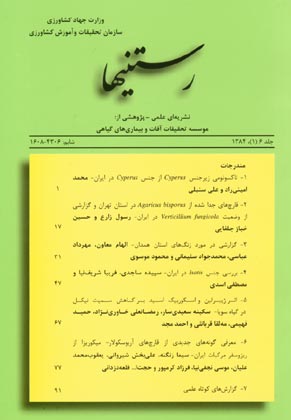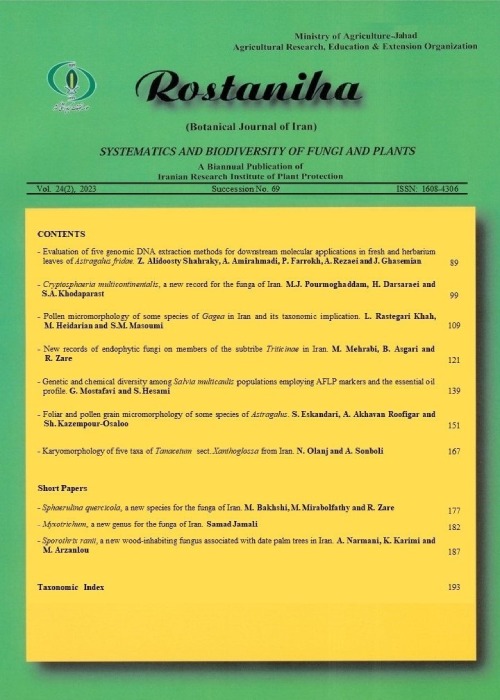فهرست مطالب

نشریه رستنیها
سال ششم شماره 1 (پیاپی 21، بهار و تابستان 1384)
- 136 صفحه،
- تاریخ انتشار: 1384/09/15
- تعداد عناوین: 7
-
-
صفحه 1جنس Cyperus یکی از جنس های بزرگ تیره Cyperaceae به شمار می آید که به دلیل تغییر صفات مورفولوژیکی و تنوع آن ها، مرزبندی زیر جنس ها، بخش ها و شناسایی تاکسون ها در این جنس با مشکلاتی مواجه می باشد. از این جنس در فلورا ایرانیکا (جلد 173)، شش زیر جنس گزارش گردیده است که در این تحقیق زیرجنس Cyperus از نظر آرایه شناسی مورد مطالعه قرار گرفته است.
در بررسی و بازنگری 300 نمونه هرباریومی (هرباریوم ایران، هرباریوم باغ گیاهشناسی ملی ایران و...) و گیاهان تازه جمع آوری شده از مناطق مختلف کشور تعداد 10 گونه متعلق به هشت بخش تایید شدند که بر اساس ساختار گل آذین در سه گروه: گروه 1 (C. bulbosus)، گروه 2 (C. imbricatus، C. dives، C. glomeratus) و گروه 3 (C. rotundus، C. longus، C. glaber، C. serotinus، C. esculentus and C. malaccensis) قرار می گیرند. همچنین شاخص های متمایز کننده، پراکنش، رویشگاه ها، مناطق رویشی و کلید شناسایی برای گونه های ایران ارایه شده است.
کلیدواژگان: Cyperus، آرایه شناسی، ایران -
صفحه 17طی سالهای 83-1382 واحدهای عمده پرورش قارچ خوراکی در استان تهران مورد بازرسی و نمونه برداری قرار گرفت و تعداد 103 جدایه قارچ به دست آمد. از میان گونه های به دست آمده Verticillium fungicola (با 50 جدایه)، Trichoderma harzianum (با 24 جدایه)، Cladobotryum dendroides (با 16 جدایه) و Acremonium crotocinigenum (با 11 جدایه) بالاترین فراوانی را داشتند. گونه A. crotocinigenum برای اولین بار از ایران گزارش می شود. معیار آزمون دمایی جهت تشخیص دوگونه T. harzianum و T. aggressivum معیار قابل اعتمادی نیست زیرا جدایه های ایرانی که تحت نام T. harzianum معرفی شده اند از نظر دمانی مشابه T. aggressivum هستند اگر چه احتمال دارد که جدایه های ایرانی نماینده گونه جدیدی از تریکودرما باشند. در مقایسه مولکولی در سطح ITS مشخص شد که از V. fungicola دو واریته Fungicola و Flavidum در ایران وجود دارند. این دو واریته با معیارهای مورفولوژیکی از یکدیگر قابل تشخیص نمی باشند.
کلیدواژگان: قارچ های قارچزی، Verticillium fungicola، Agaricus bisporus، Cladobotryum، Acremonium، Trichoderma -
صفحه 31بر اساس بررسی فلوریستیک قارچ های راسته زنگ ها (Uredinales) در استان همدان تعداد 20 آرایه از این راسته شامل Aecidium muscari، A. ranunculi-acris، Melampsora allii-fragilis، M. epitea var. epitea، M. euphorbiae، Phragmidium kamtschatkae، Ph. Sanguisorbae subsp، Puccinia cesatii، P. cnici، P. cchinopis، P. sii-falcariae، P. hariotii، P. hieracii، P. pulvivata، P. punctiformis، Uromyces acantholimonis var. Zagrosica، U. fallens، U. glycyrrhizae، U. inaequialtus var. ecbatanensis var. nov. و U. tinctoriicola گزارش می شوند. از این بین آرایه U. inaequialtus var. ecbatanensis به عنوان واریته جدید برای جهان و آرایه های M. allii-fragilis و U. acantholimonis var. zagrosoca به عنوان آرایه های جدید برای فلور زنگ های ایران معرفی می شوند. همچنین مرحله اسیومی M. epitea var. epitea روی Dactylorhiza umbrosa و Ph. Sanguisorbae mediteraneum روی Sanguisorba minor برای اولین بار در ایران گزارش می گردند. میزبان های جدیدی برای زنگ های شناسایی شده معرفی می شوند و اطلاعاتی در خصوص چرخه زندگی برخی گونه ها ارایه می گردد.
کلیدواژگان: زنگ، فلور قارچی، همدان، Uredinales -
صفحه 47در تحقیق حاضر جنس Isatis L. در ایران مورد بررسی مورفولوژیکی و تاکسونومی عددی قرار گرفت. برخی از نتایج حاصل از این بررسی عبارتند از: معرفی یک زیر گونه جدید برای دنیا به نام I. cappadocica subsp. Kurdica گزارش دو گونه و یک زیر گونه برای اولین بار برای فلور ایران با نام های I. ornithorhynchus، I. spectabilis، I. tinctoria subsp. Tomentella، گزارش مجدد گونه I. tinctoria، انتقال گونه های P. brevipes، P. multicaule، P. stocksii از جنس Pachypterygium به جنس Isatis، تهیه عکس از کل گیاه و اجزای مهم مانند میوه، برگ و گوشک و طرح های ترسیمی در موارد مهم، ترسیم میوه گونه ها و زیرگونه ها برای اولین بار در ایران، ارایه کلید شناسایی جدید بخش ها و گونه های جنس Isatis و زیر گونه های I. cappadocia و تهیه نقشه های پراکنش، اصلاح طبقه بندی بخش ها و جایگاه برخی گونه ها، از جمله، انتقال I. trachycarpa از بخش Isatis به Eremoglaston.
کلیدواژگان: مورفولوژی، تاکسونومی عددی، Brassicaceae، Isatis، Pachypterygium -
صفحه 67
در این پژوهش، آثار برهم کنش نیکل، ژیبرلین و اسکوربیک اسید در سویا (Glycine max L. cv. Union × Elf) مورد بررسی قرار گرفت. دانه رست های هفت روزه که در محیط هیدروپونیک رشد یافته بودند، در معرض غلظت های مختلف نیکل کلرید (0 و 0.5 میلی مولار) و ژیبرلین (0 و 0.05 میلی مولار) و اسکوربیک اسید (0 و 1 میلی مولار) قرار گرفتند. علایم سمیت نیکل مانند تشکیل لکه های قرمز – قهوه ای در سطح پهنک برگ در گیاهان تحت تیمار نیکل مشاهده شد. افزودن ژیبرلین و یا اسکوربیک اسید به محیط کشت، آثار سمی نیکل را کاهش داد. قابل توجه این که، هنگام کاربرد هم زمان ژیبرلین و اسکوربیک اسید، علایم سمیت Ni بروز نکرد. نیکل موجب کاهش وزن خشک ریشه و اندام های هوایی و همچنین کاهش کلروفیل در برگ ها شد. افزایش سطح مالون دی آلدهید (MDA) و تغییر فعالیت آنزیم های آنتی اکسیدان مانند کاتالاز (CAT) و گایاکول پراکسیداز (GPX) در ریشه ها و برگ ها نشان دهنده بروز تنش اکسایشی در سویا بود، در حالی که گیاهان تحت تیمار نیکل که در معرض ژیبرلین یا اسکوربیک اسید و بویژه ژیبرلین و اسکوربیک اسید قرار گرفته بودند، رشد بهتری داشتند. بر هم کنش ژیبرلین و اسکوربیک اسید از کاهش کلروفیل و پراکسیداسیون لیپیدها جلوگیری نمود و فعالیت آنزیم های کاتالاز و پراکسیداز را افزایش داد. این نتایج نشان می دهد که بر هم کنش ژیبرلین و اسکوربیک اسید، آثار سمی نیکل را در دانه رست های سویا کاهش می دهد.
کلیدواژگان: نیکل، ژیبرلین، اسکوربیک اسید، آسیب اکسایشی، سویا -
صفحه 77
طی انجام طرح جمع آوری و شناسایی قارچ های همزیست مرکبات، در سالهای 1380 تا 1382، تعداد 164 نمونه خاک از عمده ترین مناطق زیر کشت مرکبات، شامل استان های فارس، گیلان، مازندران، کرمان، هرمزگان و سیستان و بلوچستان جمع آوری گردید. نمونه های خاک به دست آمده با روش الک تر شستشو و سپس سانتریفوژ شد. از هاگ های به دست آمده، لام میکروسکوپی تهیه گردید و مورد بررسی قرار گرفت. بر اساس مطالعه و تعیین نام نمونه ها، از 23 گونه قارچ میکوریزایی تشخیص داده شده، پنج گونه نامبرده زیر برای فلور قارچی ایران جدید بوده اند:Glomus albidum، G. diaphanum، G. invermaium، G. tortusum، Scutellospora erythropa
کلیدواژگان: آربوسکولار، میکوریزا، مرکبات، فارس، گیلان، مازندران، کرمان، هرمزگان و سیستان و بلوچستان -
صفحه 90
-
Page 1The genus Cyperus belongs to tribe Cypereae, subfamily Cyperoideae and family Cyperaceae that is the largest genus in this family after Carex. The classification of genus Cyperus is still unsettled because of morphological variations and therefore, makes determination of subgenera boundaries and species difficult. In Flora Iranica (KUKKONEN 1998) this genus was divided to six subgenera. In this research, taxonomic revision of subgenus Cyperus in Iran were studied. Out of 300 herbarium specimens (IRAN, TARI etc. Herbaria) and newly collected plants from different parts of the country, 10 species belonging to eight sections are identified. The results showed that, based on inflorescence type, this subgenus may be divided to three groups as follow: group 1 (C. bulbosus), group 2 (C. imbricatus, C. dives, C. glomeratus) and group 3 (C. longus, C. rotundus, C. serotinus, C. glaber, C. esculentus and C. malaccensis).Keywords: Cyperus, taxonomy, Iran
-
Page 17During 2003-04 major mushroom production units of Tehran province were sampled and 103 fungicolous isolates were obtained (Table 1). Verticillium fungicola (with 50 isolates), Trichoderma harzianum (with 24 isolates), Cladobotryum dendroides (with 16 isolates) and Acremonium crotocinigenum (with 11 isolates) were the most frequent fungi associated with the cultivated mushroom, Agaricus bisporus. The report of A. crotocinigenum and two varieties of V. fungicola (fungicola and flavidum) is new to the mycoflora of Iran. The validity of temperature tests for distinction between T. harzianum and T. aggressivum is under question as the Iranian isolates of T. harzianum have the same growth rate as those of T. aggressivum, but based on molecular data (AFLP) they are different from both species. They could however represent a new taxon. Verticillium fungicola causes dry bubble disease and also distortion and mummification of the fruit-bodies of Agaricus bisporus (Fig. 1). The two varieties are indistinguishable from each other on morphological grounds (Fig. 3), but they are distinct at ITS level (Fig. 2).Keywords: Agaricus bisporus, fungicolous fungi, Verticillium fungicola, Cladobotryum, Acremonium, Trichoderma
-
Page 31Based on the morphological study of specimens of rust fungi collected during 2002-2003, a contribution is made to the rust fungus flora of Hamedan province: Uromyces inaequialtus var. ecbatanensis is described as new taxon. Melampsora allii-fragilis and Uromyces acantholimonis var. zagrosica are new reports for Iran. New observations on already known species were made: the aecia of Melampsora epitea var. epitea on Dactylorhiza umbrosa and Phragmidium sanguisorbae subsp. mediteraneum on Sanguisorba minor are newly recorded from Iran. Muscari neglectum for Aecidium muscari, Salix aegyptiaca for Melampsora epitea, Euphorbia seguieriana for Melampsora euphorbiae, Acantholimon latifolium for Uromyces acantholimonis var. zagrosica and Euphorbia macroclada for Uromyces tinctoriicola are reported as new hosts at least in Iran.Keywords: Rust, Hamedan, Fungus flora, Uredinales
-
Page 47This paper presents the findings of a research on the genus Isatis L.(Brassicaceae) in Iran. Isatis specimens kept in major herbaria of Iran were examined carefully. Fresh specimens were collected from Tehran, Mazandaran, Semnan, Hamedan, Kurdistan, W. Azarbaijan, E. Azarbaijan, Ardebil and Ghazvin provinces. Images of type or otherwise valid specimens kept in Viena, Munich, Montpollier and Kew herbaria were obtained and considered in the research. The relationships between the species were also studied using numeric taxonomy method. The species of the genus Pachypterygium found in Iran were included in the numeric taxonomy beside the genus Isatis L. Hierarchical clustering analysis was carried out based on 69 characteristics. Dendrograms and plots were drawn.Keywords: Isatis, Brassicaceae, numeric taxonomy, Pachypterygium
-
Page 67
The interactive effects of nickel (Ni) and ascorbic acid (AsA) and gibberellin (GA3) on soybean seedlings (Glycine max L. cv. Union × Elf) were examined. Seven-day old hydroponically-grown seedlings were exposed to NiCl2, 6H2O (0.5 mM), either with or without AsA (1 mM) or GA3 (0.05 mM) or AsA (1 mM) plus GA3 (0.05 mM), for five days. Nickel toxicity symptoms, such as formation of reddish-brown mottled spots on the leaf blade, observed in Ni-treated plants. Addition of GA3 or AsA to the culture medium reduced toxic effects of nickel. Interestingly, with application of GA3 plus AsA, these symptoms did not appear in Ni-stressed plants. Ni decreased dry weights of both roots and shoots and reduced chlorophyll content in leaves. An enhanced level of malondialdehyde and changes in the activities of the antioxidant enzymes, catalase (CAT, EC 1.11.1.6) and guaiacol peroxidase (GPX, EC 1.11.1.7), in both roots and leaves indicated that Ni caused oxidative stress in soybean plants.
Keywords: Nickel, Gibberellin, ascorbic acid, Oxidative damage, Soybean -
Page 77
During 2001-2002, a total number of 164 soil-root samples were collected from citrus orchards of six provinces, namely, Fars, Gilan, Mazandaran, Kerman, Hormozgan and Sistan va Baloochestan. Soil samples were decanted and centrifuged and spores were collected and examined. Out of 23 identified species, five species were recognized new to Iran mycoflora. New species are as follows: Gomus albidum, G. diaphanum, G. invermaium, G. tortusumand Scutellospora erythropa.
Keywords: Arbuscular mycorrhiza, citrus, Fars, Gilan, Mazandarn, Kerman, Hormozgan, Sistan va Baloochestan -
Page 90


